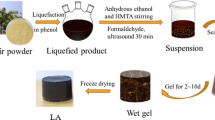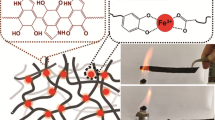Abstract
Lignocellulosic nanofibrils (CNFs) are among the most well-known renewable and biocompatible materials. Aerogels assembled from these high aspect ratio CNFs are highly porous and ultralight. However, CNF aerogels ultimately exhibit unsatisfactory mechanical properties. This work reports the lamellar-aligned structural design to prepare an elasticity-enhanced CNF aerogel through the combination of chemical grafting with a water-soluble vinyl monomer and gradient freezing, thereby focusing on the relationship between structure and performance. Morphological characterization by scanning electron microscope showed that the large-scale lamellar/porous structure of the elasticity-enhanced aerogel exhibited flyweight densities of 3.31 mg/cm3, porosity of 99.77%, enhanced elasticity at 70% strain, and over 85.4 times water adsorption (by weight) at 20 °C for 20 cycles. Moreover, the carbonized lamellar-aligned aerogel exhibited anisotropic electrical resistivity. The interesting effects of anisotropy and the more environmentally friendly preparation are important contributions to the CNF light porous materials. The fascinating large-scale lamellar-aligned renewable aerogel may be useful for applications such as energy storage, strain sensors, and thermal insulation.






Similar content being viewed by others
References
Bai H, Walsh F, Gludovatz B, Delattre B, Huang C, Chen Y, Tomsia AP, Ritchie RO (2016) Bioinspired hydroxyapatite/poly(methyl methacrylate) composite with a nacre-mimetic architecture by a bidirectional freezing method. Adv Mater 28:50–56
Chen Y, Fan D, Han Y, Li G, Wang S (2017) Length-controlled cellulose nanofibrils produced using enzyme pretreatment and grinding. Cellulose 24:5431–5442
Chen Y, Fan D, Lyu S, Li G, Jiang F, Wang S (2019a) Elasticity-enhanced and aligned structure nanocellulose foam-like aerogel assembled with cooperation of chemical art and gradient freezing. ACS Sustain Chem Eng 7:1381–1388
Chen Y, Yang S, Fan D, Li G, Wang S (2019b) Dual-enhanced hydrophobic and mechanical properties of long-range 3D anisotropic binary-composite nanocellulose foams via bidirectional gradient freezing. ACS Sustain Chem Eng 7:12878–12886
Cheung KC, Gershenfeld N (2013) Reversibly assembled cellular composite materials. Science 341:1219–1221
Figueiredo AG, Figueiredo AR, Alonso-Varona A, Fernandes SC, Palomares T, Rubio-Azpeitia E, Barros-Timmons A, Silvestre AJ, Pascoal Neto C, Freire CS (2013) Biocompatible bacterial cellulose-poly(2-hydroxyethyl methacrylate) nanocomposite films. Biomed Res Int. https://doi.org/10.1155/2013/698141
Guan H, Cheng Z, Wang X (2018) Highly compressible wood sponges with a spring-like lamellar structure as effective and reusable oil absorbents. ACS Nano 12:10365–10373
Guo L, Chen Z, Lyu S, Fu F, Wang S (2018) Highly flexible cross-linked cellulose nanofibril sponge-like aerogels with improved mechanical property and enhanced flame retardancy. Carbohydr Polym 179:333–340
Han X, Bao J (2018) General method to correct the fluctuation of acid based pretreatment efficiency of lignocellulose for highly efficient bioconversion. ACS Sustain Chem Eng 6:4212–4219
Jeon JW, Kwon S, Lutkenhaus J (2015) Polyaniline nanofiber/electrochemically reduced graphene oxide layer-by-layer electrodes for electrochemical energy storage. J Mater Chem A 3:3757–3767
Jiang F, Hsieh YL (2014) Assembling and redispersibility of rice straw nanocellulose: effect of ter-butanol. ACS Appl Mater Interfaces 6:20075–20084
Jiang F, Hsieh YL (2016) Amphiphilic superabsorbent cellulose nanofibril aerogels. J Mater Chem A 2:6337–6342
Jiang F, Hsieh YL (2017) Cellulose nanofibril aerogels: synergistic improvement of hydrophobicity, strength, and thermal stability via cross-linking with diisocyanate. ACS Appl Mater Interfaces 9:2825–2834
Jiang J, Zhang Q, Zhan X, Chen F (2017) Biomass derived, honeycomblike aerogel as a robust oil absorbent with two-way reusability. ACS Sustain Chem Eng 5:10307–10316
Khan RA, Parsons AJ, Jones IA, Walker GS, Rudd CD (2009) Surface treatment of phosphate glass fibers using 2-hydroxyethyl methacrylate: fabrication of poly (caprolactone)-based composites. J Appl Polym Sci 111:246–254
Lee J, Deng Y (2011) The morphology and mechanical properties of layer structured cellulose microfibril foams from ice-templating methods. Soft Matter 7:6034–6040
Li Y, Zhu H, Zhu S, Wan J, Liu Z, Vaaland O, Lacey S, Fang Z, Dai H, Li T, Hu L (2015) Hybridizing wood cellulose and graphene oxide toward high-performance fibers. NPG Asia Mater. https://doi.org/10.1038/am.2014.111
Liu G, Button TW, Zhang D (2014) Lamellar BaTiO3 and its composites fabricated by the freeze casting technique. J Eur Ceram Soc 34:4083–4088
Liu H, Geng B, Chen Y, Wang H (2017) A review on the aerogel type oil sorbents derived from nanocellulose. ACS Sustain Chem Eng 5:49–66
Lou X, Munro S, Wang S (2004) Drug release characteristics of phase separation pHEMA sponge materials. Biomaterials 25:5071–5080
Maatar W, Boufi S (2015) Poly(methacylic acid-co-maleic acid) grafted nanofibrillated cellulose as a reusable novel heavy metal ions adsorbent. Carbohydr Polym 126:199–207
Meza LR, Das S, Greer JR (2014) Strong, lightweight, and recoverable three-dimensional ceramic nanolattices. Science 345:1322–1326
Munier P, Gordeyeva K, Bergström L, Fall AB (2016) Directional freezing of nanocellulose dispersions aligns the rod-like particles and produces low-density and robust particle networks. Biomacromolecules 17:1875–1881
Pan Z, Nishihara H, Iwamura S, Sekiguchi T, Sato A, Isogai A, Kang F, Kyotani T, Yang Q (2016) Cellulose nanofiber as a distinct structure-directing agent for xylem-like microhoneycomb monoliths by unidirectional freeze-drying. ACS Nano 10:10689–10697
Qiu H, Yang S, Han Y, Shen X, Fan D, Li G, Chu F (2018) Improvement of the performance of plantation wood by grafting water-soluble vinyl monomers onto cell walls. ACS Sustain Chem Eng 6:14450–14459
Rosso F, Barbarisi A, Barbarisi M, Petillo O, Margarucci S, Calarco A, Peluso G (2003) New polyelectrolyte hydrogels for biomedical applications. Mater Sci Eng C 23:371–376
Saito T, Nishiyama Y, Putaux JL, Vignon M, Isogai A (2006) Homogeneous suspensions of individualized microfibrils from TEMPO-catalyzed oxidation of native cellulose. Biomacromolecules 7:1687–1691
Schaedler TA, Jacobsen AJ, Torrents A, Sorensen AE, Lian J, Greer JR, Valdevit L, Carter WB (2011) Ultralight metallic microlattices. Science 334:962–965
Si Y, Yu J, Tang X, Ge J, Ding B (2014) Ultralight nanofibre-assembled cellular aerogels with superelasticity and multifunctionality. Nat Commun. https://doi.org/10.1038/ncomms6802
Song J, Chen C, Zhu S, Zhu M, Dai J, Ray U, Li Y, Kuang Y, Li Y, Quispe N, Yao Y, Gong A, Leiste UH, Bruck HA, Zhu JY, Vellore A, Li H, Minus ML, Jia Z, Martini A, Li T, Hu L (2018) Processing bulk natural wood into a high-performance structural material. Nature 554:224–228
Sultana S, Khan RA, Shahruzzaman M, Khan MA, Mustafa AI, Gafur MA (2010) Effect of gamma radiation on the physico-and thermo-mechanical properties of gelatin-based films using 2-hydroxyethyl methacrylate (HEMA). Polym Plast Technol Eng 49:662–671
Syverud K, Kirsebom H, Hajizadeh S, Chinga-Carrasco G (2011) Cross-linking cellulose nanofibrils for potential elastic cryo-structured gels. Nanoscale Res Lett 6:626
Wang M, Anoshkin IV, Nasibulin AGN, Juuso TK, Jani S, Jaakko P, Esko IK, Robin HAR, Olli I (2013) Modifying native nanocellulose aerogels with carbon nanotubes for mechanoresponsive conductivity and pressure sensing. Adv Mater 25:2428–2432
Wu H, Chan G, Choi JW, Ryu I, Yao Y, McDowell MT, Lee SW, Jackson A, Yang Y, Hu L (2012) Stable cycling of double-walled silicon nanotube battery anodes through solid-electrolyte interphase control. Nat Nanotechnol 7:310–315
Acknowledgements
We gratefully acknowledge support from National Nonprofit Special Fund for Fundamental Research from Chinese Academy of Forestry (CAFYBB2017SY038) and the National Natural Science Foundation of China (31700480).
Author information
Authors and Affiliations
Corresponding author
Additional information
Publisher's Note
Springer Nature remains neutral with regard to jurisdictional claims in published maps and institutional affiliations
Rights and permissions
About this article
Cite this article
Chen, Y., Yu, Z., Han, Y. et al. Combination of water-soluble chemical grafting and gradient freezing to fabricate elasticity-enhanced and anisotropic nanocellulose aerogels. Appl Nanosci 10, 411–419 (2020). https://doi.org/10.1007/s13204-019-01162-7
Received:
Accepted:
Published:
Issue Date:
DOI: https://doi.org/10.1007/s13204-019-01162-7




